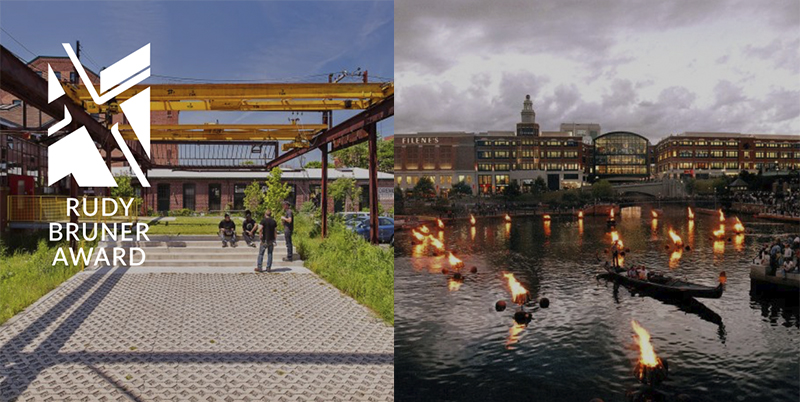Rudy Bruner Award | 30 Years of Urban Excellence
The Rudy Bruner Award for Urban Excellence (RBA) is a national design award that recognizes transformative places that contribute to the economic, environmental, and social vitality of cities. The RBA, a program of the Bruner Foundation based in Cambridge, Massachusetts, seeks to increase the understanding of the social and economic processes underlying urbanism and design practices. Since 1986, the RBA has awarded 88 projects that address place-making in critical ways often overlooked within larger architectural discourse.
Over the past 30 years the Bruner Foundation has amassed a significant archive of RBA resources including applicant submissions, winner case studies, essays, and books documenting each award cycle. All of these have been digitized with the help of the University at Buffalo. The complete RBA archive can be accessed via rudybruneraward.org and The Rudy Bruner Award Digital Archive (RBADA) at the University at Buffalo.
This collection highlights two Rudy Brunner Award recipients with both faculty and alumni connections to Rhode Island School of Design. The 2003 RBA Silver Medalist Providence River Relocation Project conceived by architects and former RISD professors Friedrich St. Florian, Irving B. Haynes and William D. Warner and RBA 2013 Silver Medalist The Steel Yard co-founded by RISD alumni Nicholas Bauta, '99 Sculpture.
-

The Steel Yard
Architecture Department, Sculpture Department, and Bruner Foundation
The Steel Yard redeveloped a historic steel fabrication facility into a campus for arts education, job training, and small-scale manufacturing in Providence, Rhode Island. The 3.5-acre property in the city’s Industrial Valley required extensive environmental remediation to meet regulatory requirements while retaining the industrial urban character of the site. The Steel Yard offers classes, workforce training, and fabrication space for local artists, creating an industrial arts incubator where they can share ideas, materials, and space. It has become a center for creative activity, bridging the gap between the traditional arts community on the affluent east side of Providence with manufacturing businesses and the industrial, lower-income west side.
The $1.2 million development occupies the former site of the 100-year-old Providence Iron and Steel Company. The property was purchased by Rhode Island School of Design graudate Nicholas Bauta and Brown University graduate Clay Rockefeller who had participated in the redevelopment of the adjoining Monohasset Mill property into artist housing. Its design is a creative response to strict regulatory requirements and the Steel Yard’s commitment to utilizing the best sustainable practices possible, even within a tight budget. Numerous public events are held on the site, including classic car shows, movie nights, and weddings.
"An exemplary model of reuse and transformation that is built on the community’s local history and talent and preserves industrial history and culture in an authentic way." 2013 RBA Selection Committee
-

The Providence River Relocation Project
Architecture Department and Bruner Foundation
The Providence River Relocation project in Rhode Island’s capital city redirected rivers, overhauled transit infrastructure, and created a new riverfront downtown. Thirty years in the making, the relocation of the Woonasquatucket and Moshassuck rivers, construction of a new rail station, highway interchanges, and twelve bridges restored historical links among Providence’s Capital Center, College Hill, and downtown. The project improved traffic flow in and through downtown and added pedestrian-friendly spaces, including 1.5 miles of river walks, along with a new urban park including a restaurant, amphitheater, fountain, and boat landing.
Redirecting the rivers created new, marketable commercial land without demolishing existing buildings in the downtown national register, resulting in over $1 billion in development. The project re-knit adjacent neighborhoods and created public arts and cultural programming that attracts locals and tourists alike to the river’s edge. With an emphasis on small urban spaces within the large-scale redevelopment, the project uses high-quality materials, and the design of the lighting, landscaping, street furniture, tree grates, signage, and historical interpretation panels all welcome the public.
"The Providence River Relocation project pays great attention to the visual, tactile, and social support aspects of each design decision as well as imparting information on history and architectural heritage." 2003 Selection Committee

